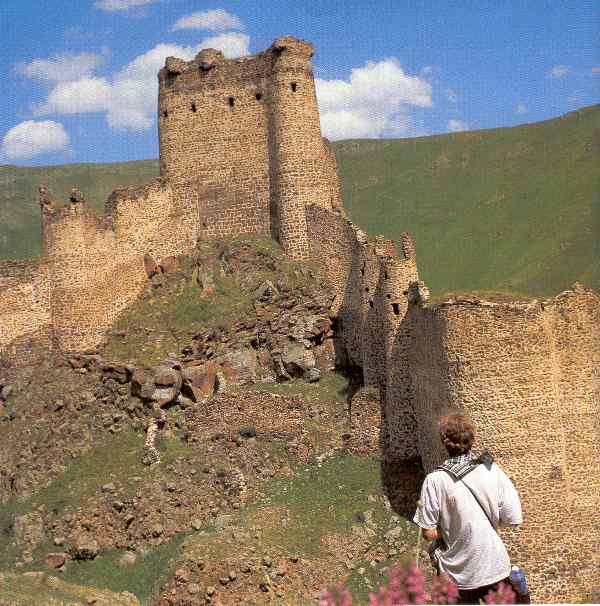Castles
Printed From: History Community ~ All Empires
Category: General History
Forum Name: Historical Pictures Gallery
Forum Discription: Post and discuss images of historical places, arts and maps...
URL: http://www.allempires.com/forum/forum_posts.asp?TID=6814
Printed Date: 08-May-2024 at 13:22
Software Version: Web Wiz Forums 9.56a - http://www.webwizforums.com
Topic: Castles
Posted By: Mila
Subject: Castles
Date Posted: 06-Nov-2005 at 21:23
|
Please share some photos and information about castles in your country! Ostrozac Castle, Bihac, Bosnia and Herzegovina Not far down the Una River you'll find it...   Ostrozac Castle is one of the most important castles in Bosnia and Herzegovina. It guarded the village of Ostrozac, now basically a suburb of the city of Bihac. It covers a huge area because in the event of attack, all the people in the surrounding villages had to be able to cram inside to help defend it.      It was home to several of Bosnia's most influential rulers and today is used as a tourist attraction, concert theatre, and a place for raves and other parties. COLTRAN FESTIVAL is held every year at the castle, the largest electronica festival in the Balkans.               ------------- |
Replies:
Posted By: erci
Date Posted: 06-Nov-2005 at 23:20
Mamure Kalesi
Cape Anamur is the southern most point of the Anatolian peninsula.
From this cape it is possible to see Cyprus and thus all the ships
sailing between Panfilia and Cilicia. A few miles to the east of the
cape, the Romans built on a small rock a little fortress, which was
enlarged by the Crusaders and later on at the beginning of the XIIIth
century it was entirely rebuilt by the Seljuk Emir of Karaman.
Mamure Kalesi is built on the waterfront and it was strengthened in
more recent times by the Ottomans, who built a fine tower on its
eastern side which offers the most evocative view of the castle
Walls inside the castle split it into three parts, in order to allow further resistance in case the enemy had
gained access to its interior.
The view from the western side shows the rocks upon which the fortress was built at the beginning.
A deep moat completed the defense of the castle. The Emir of Karaman put an inscription above the only entrance to the castle: I brought the water, I rebuilt the castle.
The castle hosted a small town with fountains, mosques and hammams.
------------- "When one hears such music, what can one say, but .... Salieri?" |
Posted By: erci
Date Posted: 06-Nov-2005 at 23:50
Alanya The Seljuks built on the headland an impressive fortification system made of long stretches of walls, towers and castles (Kale). Kizil Kule (Red Tower) is an octagonal tower built in 1226 to protect the harbour. It is so popular that it is shown on the old 250 TL note.  The access to the top of the hill was protected by three curtain-walls with over 100 towers. The gates had inscriptions celebrating the Seljuk sultans.  The walls on the eastern side of the headland are very well preserved. They clearly show that they were built before the invention of modern artillery. Because of the loss of importance of Alaye, the Ottomans did not care to bring them up to the new warfare requirements.  Ehdemek Kale is a large fortress which hosted the main buildings of the town. Today its covered market (bedesten) is a fine hotel. The mosque in Ehdemek Kale was built in the XVIIth century upon a Seljuk mosque. In the upper fortress (Iç Kale) the ruins of a little Byzantine church are the only memory of that historical period. ------------- "When one hears such music, what can one say, but .... Salieri?" |
Posted By: Mila
Date Posted: 07-Nov-2005 at 00:02
|
Great pics, erci! Tesanj Castle, Tesanj, Bosnia and Herzegovina Tesanj is a small town in northern Bosnia and Herzegovina. It is one of the only Muslim towns that survived WWI, WWII, and 1992-1995 relatively unscathed and so it's a nice glimpse into how much of Bosnia used to look - before the commieblocks went up. The castle is typical of village defenses throughout Bosnia and Herzegovina only it is completely restored and still in use, so looks far newer. ------------- |
Posted By: erci
Date Posted: 07-Nov-2005 at 00:18
Bodrum Castle        Devil's Castle, Kars
|
Posted By: Mila
Date Posted: 07-Nov-2005 at 00:21
|
Srebrenik (NOT Srebrenica), Bosnia and Herzeogovina Srebrenik is a tiny town with one of Bosnia's most impressive castles. It's built high in th alps overlooking several towns and villages, but it is named for the town of Srebrenik. A significant portion of the castle is actually carved out of stone. It is almost impossible to reach unless the rope bridge is in place.  View of Srebrenik from the castle:  ------------- |
Posted By: ill_teknique
Date Posted: 07-Nov-2005 at 00:52
|
bosna is beautiful. i've seen some of the old castles around the
krajina -from bihac to velika kladusa - havent been in bosna since 98
when i moved from munich to chicago. im planing to go back
hopefully this upcoming summer.
------------- |
Posted By: JiNanRen
Date Posted: 07-Nov-2005 at 15:21
      |
Posted By: Mila
Date Posted: 07-Nov-2005 at 15:32
|
Dragon of Bosnia Tower - Kula Zmaj od Bosne
Gradačac, Bosnia and Herzegovina  The Dragon of Bosnia Tower is not only
one of the most beautifully restored castles in Bosnia and Herzegovina,
it is also the most historically important one. There is no other
castle in the country which burns the hearts of Bosnians who look at it
with such pride.
The castle was home to Husein-kapetan Gradačević, who came to be known as the Dragon of Bosnia. Gradačević was born in http://en.wikipedia.org/wiki/Grada%C4%%3Cimg%20border=" 0="" src="smileys/smiley16.gif" border="0"> Gradačac in 1802 and grew up surrounded by a political climate of turmoil in the western reaches of the Ottoman Empire. When his brother Murat was poisoned by a rival in 1821, Gradačević rose to the head of the Gradačac military captaincy. The young Husein developed a reputation for wise rule and tolerance and soon became one of the most popular figures in Bosnia. In 1831, Gradačević was called upon to lead the movement for Bosnian autonomy. He overthrew the loyalist Vizier and other anti-rebellion figures, becoming the de facto ruler of the Bosnian administrative unit in the process. On July 18 of the same year, Gradačević met a large force commanded by the grand vizier himself near Shtimje/timlje in Kosovo and dealt a heavy defeat to the imperial army. At that point, he decided to turn back from further campaigns and returned to Bosnia where he was proclaimed the new Vizier by his soldiers on September 12. He offered the Ottoman Empire peace in exchange for Bosnian independence. By 1832, however, the tide of the rebellion had turned. After a series of smaller clashes, the decisive battle occurred on the 17th and 18th of May outsideSarajevo. Initially successful, the rebels were eventually defeated when Herzegovinan reinforcements arrived and sided with the Sultan. Although the Bosniak uprising would not be completely quelled for another 18 years, Gradačević was forced to flee to the Austro-Hungarian Empire on May 31 http://en.wikipedia.org/wiki/May_31" title="May 31 - . From there he negotiated for his return with the Sultan and was ultimately allowed back but barred from ever entering Bosnia again. He moved to Belgrade and then to Istanbul, where he died under mysterious circumstances on August 17, 1834. A legend in his own time, Gradačević is considered a Bosniak national hero and one of the most revered figures in the history of Bosnia and Herzegovina http://en.wikipedia.org/wiki/History_of_Bosnia_and_Herzegovina" title="History of Bosnia and Herzegovina - . There was a well-known saying among Bosniaks that for years after his death not a single man among our people would be able to hear his name and not shed a tear. This positive sentiment was not exclusive to the Muslim population, as Christians from Posavina are thought to have shared a similar view for decades.      "God I fear slightly, the Sultan not at all, and the Grand Vizier no more than my own horse." - http://en.wikipedia.org/wiki/Husein_Grada%C5%A1%C4%%3Cimg%20border=" 0="" src="smileys/smiley16.gif" border="0">Husein-kapetan Gradačević ------------- |
Posted By: kotumeyil
Date Posted: 08-Nov-2005 at 10:13
|
Citadel of Ankara (my home city). The orange buildings below the picture are brothels
------------- [IMG]http://www.maksimum.com/yemeicme/images/haber/raki.jpg"> |
Posted By: Behi
Date Posted: 09-Nov-2005 at 05:21
|
http://www.allempires.com/forum/forum_posts.asp?TID=4322&a mp;get=last
------------- |
Posted By: Behi
Date Posted: 09-Nov-2005 at 05:28
|
Bam, Kerman, Iran photos b4 terrible earthquake  Once a famous citadel and strategic stronghold, this fort has been built on a huge rock and covers an area of six square kilometers in all. It is 300 meters long and 200 meters wide and consists of two parts. The fort is a five-story structure of unbaked brick and must have been constructed before the fifth and sixth centuries A.H. (11th and 12th centuries A.D.). The place has undergone frequent repairs and comprises a rampart, an ancient entrance, adequate fortifications, some Safavid structures, a mosque, and a building known as (Char-Fasl) or (Palace of four seasons). There are two inscriptions in this vast and magnificent construction, which are indicative of recent reparations. Both tablets bear the date 20th Azar 1337 S.H. year (1958 A.D.); one of these has been installed by the society for the Preservation of National Monuments and the other, by the Department of Archaeology. The next of the latter is as follows: (The Citadel of Bam, which was habitable and in a fairly good condition until a hundred and fifty years ago, has, according to (Hundud al-Alam) and other reliable sources that have come down to us from 4th century A.H. (10th century A.D.), been founded some 2000 years back, and has been repeatedly repaired thereafter. This commemorative tablet relates to the completion of the repairs of the watchtower and a part of the Governor`s residence. Azar 1337. Department of Archaeology. (Kerman is the heart of the world ...) so says Shah Nemat-ol-lah-e-vali, the well known sufi-poet of the 8th century A.H. (Heart of the world) is as old as the history itself. R. Frye in the Heritage of Persia ( London,1962) brings up the possibility that the Kermani or Germani tribe has given its name to the area of its residence. Berossus, the Chaldean historian ( 3rd cent. BC ) in his account of the fall of Babylon to Cyrus the Great says that the Persian. Shahanshah sent Nabonidus, the fallen Babylonian king, to exile in Kerman, where he resided till his death (Pirmia -Moshir- ol- Dowleh- Hassan. Iram-e-Bastan, Tehran, 1362). This, regardless of its historical accuracy, establishes Kerman as one of the major province of Iran, housing a population of 1,850,000. 190 Km to the south east of the city of Kerman, in the midst of the vast, endless, gray deserts, lies the ever-green city of Bam, the (Emerald of the Desert). This city with its extensive palm groves and citrus gardens is essentially an agricultural city, benefiting from very rich sub-terranean water reserves, surfacing through a great number of miles long (qanats), or sub-terranean aqueducts and water canals, in an area noted for the scarcity of water in it. The citrus fruits of Bam, its oranges, tangerines, its sweet lemons, are well known, and its dates, especially the (Mozafati) brand, a unique well known for its delicacy are of universal fame. Lately, while the opening of new international markets have revitalized the agricultural activities in the area, pumping new blood in its old veins, some industrial projects are to change the whole economic, and, therefore, social texture of the city, bringing it to the competitive world of the industrial age, with all its hassles turmoil,... and confusions, the new car manufacturing project of the (Kerman Automotive Industries Co.), being the most notable of all these projects. But Bam is known all through the world for a different aspect of it: Arg-e-Bam or the ancient citadel and the ruins of the ancient town surrounding it. This is one of the most splendid historical sites in the whole world: while most of the best known historical sites in the world, like Fars (Persepolis, Athen`s Acropolis, Rome`s forum and Coliseum, Paris` Versailles,... signify a limited period in history, Arg-e-Bam displays the imprints of 2000 continuous years of a dramatic, eventful history from its foundation, presumably during the Parathion period (250 BC - 224 AC), up until about 150 years ago when in the reign of Nasser-a-Din Shah Qajar (1831-1896, king 1548-1896) the ancient town was gradually deserted. This peculiarity has made estimation of the precise age of most parts of this historical complex rather difficult, sometimes even impossible. The legends have it that the city was founded by Bahman, the son of Esfandiar, one of the legendary kings in the Esfahnameh, corresponded to Ardashir the Long Armed (Artaxerexes Longimanus, 429 BC, king 464-424) son of Xerexes I, the Achamenide King-of-Kings. However, most of the historians refer to the story of (Haftvad) in the Shahnameh, or (Haptanbad) in the Karnamak-e-Ardashir-e-Papkan, a historically true story, as the story, and the date, of the foundation of Bam. If so, this date goes back to the late, or mid, Parathion period although a thorough scientific and archeological inspection of the site is still needed. There are some signs and indications like some Parathion coins found here - which make it a safe guess to assume that the nucleus part of the town and the citadel belonged to the Parthian period in its original form. Judging from the story of Haftvad` and also by comparing the ruins of Ghal-e-Do (the Maiden Fortress) to the north of Arg, and the original structure of the citadel, with the Parthian town model (like the ruins of Parthaunisa in Turkmenistan), it is obvious that originally the town and the residential quarters for the common people were located couple of miles to the west of the Arg, in the place of today`s Koozeran-corresponding the Kojaran of the Shahnameh and the adjacent Dehshotor quarters, while the residence of the governing prince was in the Ghal-e-Dokhtar, where, according to the Parthian- and maybe Achamenide-model, it was also the temple for the official court religion. There is an ornamental figure carved on the wall of an altar on the eastern side of Ghal-e-Dokhtarl which resembles very much to a similar figure on the altar of another very important, hut, alas, a very little known site about 2 Km to the east of the Arg, known as (Char Taghi`. As the story goes, after Haftvad rebelled against the governing prince and killed him, he made a citadel and a fortress on a rock-hill to the west of the town, corresponding to the present site of the Arg. After Haftvad was defeated and killed by Ardashir, the victorious king destroyed the main citadel in the fortress and built a fire-temple in it instead, which, it is believed, was turned into the existing main observation tower and the Char-Fasl building in the Islamic period. In any event, 2000 years of history, with all its ups and downs, with all its wars, internal strives, periods of peace, of calm, of blooming, of blood, of destructions, of developments, of massacres,.., have left their imprints on this site of history which cries out the transient nature of (being) and the external essence of the universe. Walking through the ruins of the Arg, one feels as if every broken wall, every pass-way where people of centuries have walked through, where horses of history have run through, every little stone, every molecule of earth, recites along with Khayyam: Think, in this battered Carvanserai Whose Doorways are alternate Night and Day How Sultan after Sultan with his romp Abode his Hour or two, and went his way The ruins of the Arg as a whole are so interesting, remarkable and mind arousing that it takes more than one visit to absorb and to appreciate the historical significance of the details. An attempt to introduce different parts of the Arg would require a huge volume. However, as Mulffna says, (if the whole sea can`t be taken in, one may drink as much as his thirst would allow.`; so, here`s some very brief descriptions of` some of the more interesting parts: 1- The main (southern) gate: This is the only remaining gate of at least four gates. 2- The Bazaar or the main market place: Right after passing through the gate you enter a pass-way about 60 meters long which used to be the main bazaar of the town. Presumably built in the Safavid period, it had been a roofed bazaar, built, as it was the usual practice in the Safavid period, on a predrawn plan provided by the government. This bazaar, which apparently was active up until early 14th cent. A.H. (early 20Lh cent. A.D.), had replaced some other ancient bazaars of the town, like the (Pol-e-Gargan), which Moghadassi (late 4th cent. AH, 10th cent. AD) has mentioned in Ahsan-al-Taghasim, but its whereabouts are obscure now. It is noteworthy that Bam was a male commercial and trading town on the famous (Spice Road), a major tributary of the (Silk Road), connecting India, the Indian Ocean, the Omman - or the Arabian-sea, and the Persian Gulf to that main road of wealth of wealth and trade in the middle Ages. Bam was also a major center of textile industry in those days, known for its differnt fine fabrics all through the Islamic world. 3- The Grand Mosque, which was originally built in the Saffari period, 3rd. cent. AH (9th cent. AD), according to Prof. Pope, has gone through major changes in different periods. 4- The Stables and the Garrison or the Armory, both presumably built in the Saljouq or the Timurid period (6th or 8th cent. AH, 13th or 15th cent. AD). 5- The governor`s quarters and the Chahar-Fasl (Four Seasons) Building, and also the main observation tower, presumably belonging to the Safavid period (early 10th cent, mid 12th cent. AH, early 16th cent., mid 18th cent. AD) in their present forms. It is thought that the Chahar-Fasl and the main observation tower were originally a fire-temple of the pre-Islamic period. These were some very fragmentary notes on just some of the more important parts of the Arg; as I said a rightful introduction of different parts of the Arg, even a thorough introduction of only the parts mentioned, would require a huge volume, as huge as the history itself, for this, the Arg, is the history itself. Let us just watch, and pass very gently by these ruins, because every spot that you put your foot on, there may lie a king, a swordsman, an old sage, a lover, a mother... Be careful, beware   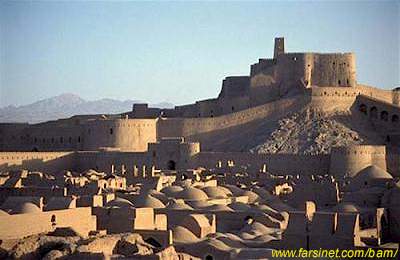  ------------- |
Posted By: Behi
Date Posted: 09-Nov-2005 at 05:47
|

This ancient castle is one of the historical structures related to the Sassanian era. It's located in the mountains of the city of Khoram Abad. A section of this palace was converted into a museum in the years 1976-1977. This museum comprises of two sections named as, an archaeology and an anthropology sector. In the year 1989, after under going repairs and the addition of yet another section that exhibited engravings and earthenware, the museum was re-opened. The original museum has begun its activities by the name of , "The Anthropological and Admiralty Metals Museum of Lurestan".
------------- |
Posted By: Beylerbeyi
Date Posted: 09-Nov-2005 at 07:25
|
http://i1.trekearth.com/photos/9034/rumelihisari.jpg">
Rumeli Hisari near (nowadays in) Istanbul, built by Mehmed II control the strait before the siege of Constantinople. A.k.a. 'throat-cutter' as the word 'throat' is same with the word 'strait' in Turkish. It is an ugly pile of stone, but nevertheless amazing, because it was built in just FOUR months. It is alleged that the sultan assigned a tower to each of his viziers and said, 'if you don't finish it on time, you are history'... On the other side of the strait is the Anadolu hisari, smaller and built earlier for the same purpose.
Here seen behind some handsome yalis (seaside mansions). So when someone tried to send help to the besieged Constantinople from the Black Sea, the ship had to pass between these two fortresses. AFAIK, some did try and some were sunk by cannon fire. Fortifications of Constantinople itself were more formidable, and can be seen in another thread. ------------- |
Posted By: kotumeyil
Date Posted: 09-Nov-2005 at 08:24
|
I read somewhere that the view from the top of Rumelihisari is like the word "Mehmed" in the Ottoman script. I think it looks so except the wall at the bottom of the pic and that wall might have been modified through centuries... ------------- [IMG]http://www.maksimum.com/yemeicme/images/haber/raki.jpg"> |
Posted By: Behi
Date Posted: 13-Nov-2005 at 02:11
|
Citadel of Karim khane Zand, Shiraz, Iran dominates the city center. This well-preserved fortress was part of the royal courtyard in the time of Zand dynasty. Today it houses the municipal offices & is not open to visitors. The area of whole place is 12800 sq.m., the height of each towers is 14 m. Inside the Arg, there are different buildings, the north building was used in winter, the south building for summer use & west building was for all seasons.
------------- |
Posted By: amir khan
Date Posted: 10-Dec-2005 at 04:38
|
Romantic view from a ruined castle in northern pakistan
Baltit Fort, Northern Pakistan
Rhotas Fort-Punjab,Pakistan Built 1540 (Sher Shah Suri)
Lahore Fort- Punjab, Pakistan
Lahore Fort- Punjab, Pakistan
Derawar fort, Cholistan Desert, Pakistan
Derawar fort
Derawar Fort
Hydrabad Fort, Sind, Southern Pakistan
"Where the streets were washed daily with perfume" http://creekin.net/c4123-n142-hyderabad-pakistan.html - http://creekin.net/c4123-n142-hyderabad-pakistan.html |
Posted By: amir khan
Date Posted: 10-Dec-2005 at 15:22
|
The Red Fort (Lal Killa) Built - Mughal Emperor Shah Jehan (1638-1648) Location - Delhi, India
Red Fort, Delhi
Red Fort, Interior
http://www.wonderclub.com/WorldWonders/red_fort_in_india.html - http://www.wonderclub.com/WorldWonders/red_fort_in_india.htm l
|
Posted By: amir khan
Date Posted: 11-Dec-2005 at 16:16
|
Mehargarh Fortress North India
|
Posted By: Raider
Date Posted: 13-Dec-2005 at 08:24
|
The Castle of Visegrád: The construction of the castle was begun in 1247 by king Béla IV. It was one of the several stone-fortification built after the mongol invasion in order to prepare the next attack. Béla IV. even sold the the family jewels of his wife Mary Lascaris to fund the building operations. This castle became the royal seat under the Angevins and the Holy Crown was kept here until the battle of Mohács. (In a brief period under Louis the Great the crown of Poland was also kept here.) In 1335 this was the place where the summit of the king of Bohemia, Hungary and Poland was held. (This summit gave the name to the modern Visegrad group or V4). Later It served as an Ottoman border fortress and was recaptured in 1686. AFter this the castle lost its military role and was abandoned. The reconstruction has begun in 1871. The picture showes the upper castle, the citadell.
The Lower Castle is at the Danube with the donjon (Solomon's Tower).
There is a good link to Hungarian castles: http://www.varak.hu - www.varak.hu
|
Posted By: Ikki
Date Posted: 13-Dec-2005 at 12:34
A wonderful fortress JiNanRen, very very impressive ¿NW frontier?
  I'm sure, the Thousand Nights and one Night must borned here. How are the reconstruction works advancing?? I'm sure, the Thousand Nights and one Night must borned here. How are the reconstruction works advancing??
Castles of Spain El Alcázar de Segovia  El Alcázar de Toledo  Las Murallas de Ávila (The Walls of Ávila)  Las Murallas romanas de Lugo (The Roman Walls of Lugo)  Castillo de Coca  El Castillo templario de Ponferrada (Templar Castle of Ponferrada) 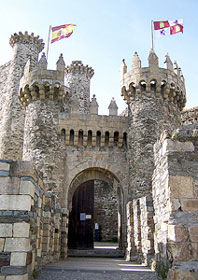 Castillo de Mota  Castle of Calatrava la Nueva:  |
Posted By: Cyprus
Date Posted: 23-Dec-2005 at 07:52
This is a Romantic ruin of castle near my home city(Bøeclav in Czech republic). It is called Janùv hrad(shortly Janohrad) which means John´s castle..it was built by the order of prince John of Lichtenstein.

|
Posted By: Svyturys
Date Posted: 20-Jan-2006 at 05:07
|
I want to write here about Lithuanian, Belarusian castles (you know Belarus was also part of Grand Duchy of Lithuania, so there are some castles of Lithuanians) 1. Medininkai castle: One of the biggest castle in Lithuania. This memorial of culture was attachmented to ring-fence type of castles. In historiography this castle is datable on XIII-XIV century. Architecture: The main accent of castle is donjon. Donjon needed to defend gates and bridge. According J. Meko tower was about 30 metres tall.
------------- Every moment, like last, neither earth, nor sky don't calculate time. Left only one heart in scorched bosom. Throbing only drums again, calling us into battle. |
Posted By: Svyturys
Date Posted: 20-Jan-2006 at 05:11
|
2. Trakai castle It's my favourite. Building finished on 1409 years. Was most strongest, and most lofty castle in Grand Duchy of Lithuania. Gothic, brick-field castle built by France example by up-to-the-minute projects.
Guess, you like it ------------- Every moment, like last, neither earth, nor sky don't calculate time. Left only one heart in scorched bosom. Throbing only drums again, calling us into battle. |
Posted By: Theodore Felix
Date Posted: 01-Feb-2006 at 15:52
|
Most casltes of Albania are in the Byzantine style. They are generally small since the terrain it is built on is rarely flat. and usually since the terrain is so mountaneous they involve simply a wall to surround the naturally difficult to access area. Thats why it took the ottomans so long to conquer it.
Kruja Castle 
Not much left of it, but it goes to show just how heavy the siges were. But there is deep national attachment to it. Gjirokaster Castle 
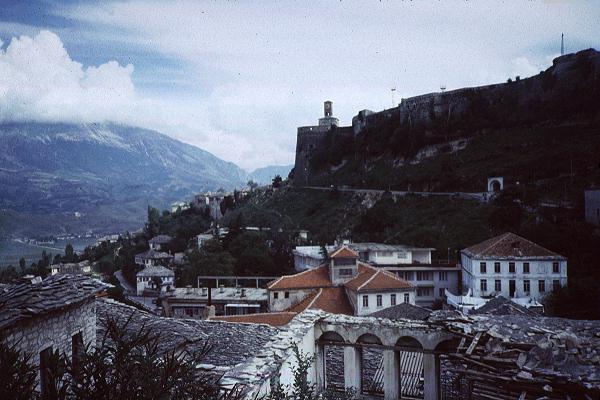
Berat Castle 
Berat, a bastardization of the name Belgrad, the original name of the city given after the Bulgarian conquest became a Byzantine style castle in its later days and because a Ottoman city afterwards. it was unique because it had its own sewer system. 
Within it are the remains of numerous churches. 


Many more. But pics are hard to find. Shkoder Probably one of the most famous castles of Albania is the Venetian castle called Rozafa. 
It contained numerous churches, Byzantine and Venetian. The Venetian ones have nearly dissappeared while many of the Byzantine ones were converted into mosques by the Turk 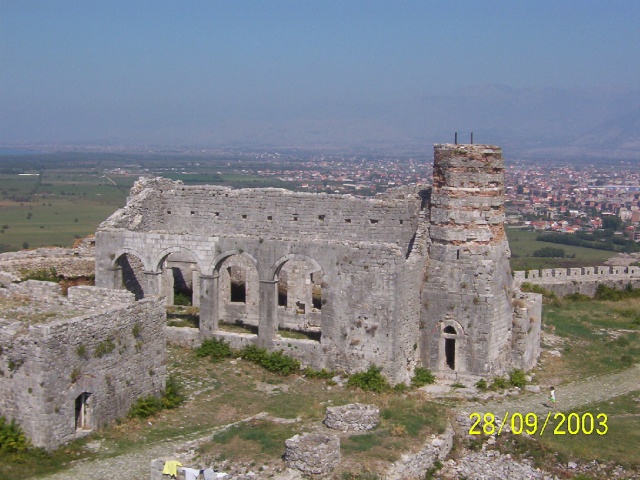 ------------- |
Posted By: Drunt Ba'adur
Date Posted: 04-Feb-2006 at 13:53
An Impressive but useless castle This is the famous castle of Neuschwanstein. Castles in Disney films were inspired by this one. It was build by Ludwig II of Bavaria(during XIX century) who was nearly crazy but also a patron. I would like to visit the castle one day Cathars castles are also impressive. They are all on the top of the mountains and some of them are really big EDIT:And I've also forgot Krak des Chaveliers. Impressive |
Posted By: Guests
Date Posted: 09-Feb-2006 at 01:53
if brothels mean whorehoueses then you are right ... i actually attend the school right next to it for a year ... just becouse my dad was the teacher .. not a good neigborhood to live at .... |
Posted By: kotumeyil
Date Posted: 09-Feb-2006 at 02:37
|
Yes I know, a poor and tough neighborhood. One of my friends is a teacher at Hacý Bayram primary school close to there. She tells me a lot about what's happening there and the life-styles of those people. However I like to walk around there and to see people in their everyday life. Also it's a nice historical place... ------------- [IMG]http://www.maksimum.com/yemeicme/images/haber/raki.jpg"> |
Posted By: Behi
Date Posted: 11-Feb-2006 at 17:30
Rayen Castle - Rayen, KermanBuilt in the same style as the Bam Citadel, but much smaller, the Rayen Castle is located in the small city of Rayen south of Kerman.
------------- |
Posted By: DayI
Date Posted: 11-Feb-2006 at 17:42
|
no images available, try to upload to AE. ------------- Bu mıntıka'nın Dayı'sı http://imageshack.us - [IMG - http://www.allempires.com/forum/uploads/DayI/2006-03-17_164450_bscap021.jpg - |
Posted By: amir khan
Date Posted: 12-Feb-2006 at 06:26
|
Another breathtaking view of Neuschwanstien...
|
Posted By: Afghanan
Date Posted: 13-Feb-2006 at 20:03
|
Old Walls over Kabul City
Old Fort in Herat
Ancient Tower of a Destroyed Fort in Ghazni
Bala Hissar, Kabul
Old Castle in Bamyan
Red Fortress in Bamyan
Farah, Afghanistan
Old Watch Tower from Destroyed Castle in Badakhshan, Afghanistan
Ancient Fort in Bamyan
Ancient Castle walls around Balkh (Bactria) - Afghanistan -- A lot of homes in Afghanistan resemble Castles with watch towers and thick walls:
These are actually peoples Homes, not castles.
------------- The perceptive man is he who knows about himself, for in self-knowledge and insight lays knowledge of the holiest. ~ Khushal Khan Khattak |
Posted By: Gharanai
Date Posted: 19-Feb-2006 at 15:38
|
Very nice pictures, and special thanks to Afghanan, I really liked those fantastic pictures that I was looking for since a while. thanks alot. ------------- 

|
Posted By: Gharanai
Date Posted: 19-Feb-2006 at 17:08
|
Below are some other pictures from me:
Arch of Victory (Taq-e-Zafar), Paghman Kabul ------------- 

|





